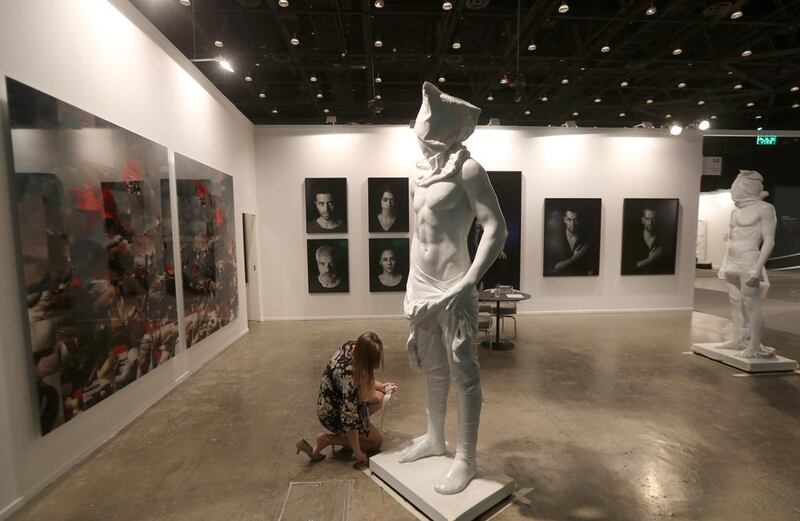Buying art is always a question of considering both aesthetics and financial investment, though you do always have the physical or electronic art work left to behold, unlike paper investments where worthless means literally that you end up with nothing.
It is also generally a lot more fun shopping around for a piece of art than many other investments. At their best artists are purveyors of curiosity and imagination as well as beauty, and the galleries magnificent spaces.
Try visiting the 53 warehouses in Al Quoz’s Alserkal Avenue during Art Week, which has begun in Dubai, and you will see what I mean.
The latest uber-cool space called ‘Concrete’ was only finished this Wednesday, just in time for a fine exhibition, Syria: Into The Light, a survey of 20th century Syrian painting featuring 40 artists active between 1924 and last year.
That said if serious money is involved then finding the right art adviser is just as important as if you were buying shares and need a knowledgeable stockbroker to help you avoid obvious errors.
Just because something looks beautiful does not mean it will rise in value, or even be saleable in the future. The name and reputation of the artist counts for a great deal and unless you spend a lot of time and effort on research you are unlikely to match the insight of a professional who does this for a living.
Personally I find it easier to look at the Middle East as a region for art investment than to consider actual individual artists. Here I can smell the air and sense an opportunity.
It’s less a matter of noting beautiful art than feeling a market that is somehow maturing and reaching critical mass, and that’s the sort of development that can mean a major escalation of value in art.
For example, this week saw the announcement of Dubai’s first privately-owned art gallery for the public, Jameel Arts Centre, set to open in 2018, a functional 10,000-square-metre, three storey complex to be built in the Culture Village on the banks of Dubai Creek.
President of Art Jameel, Fady Mohammed Jameel, also revealed a partnership with The Metropolitan Museum of Art in New York, where it will advise on art acquisitions for The Met from this region.
Indeed, it has already done so with the first two works chosen and partly paid for by a generous donation from the Jameel family. Why would they do that?
Well advancing the reputation of Middle Eastern artists is clearly a philanthropic act, though if you are also a major collector of their work then there could be a long-term payback in terms of an increase in the value of such assets.
Clever art investors with big budgets not only consider the intrinsic aesthetic worth of what they are buying but also how to add value with public relations and celebrity endorsement.
And there is no bigger celebrity in the art world than The Metropolitan Museum of Art, although Art Jameel does have existing collaborations with London’s Victoria and Albert Museum and the Prince’s School of Traditional Arts.
There is absolutely nothing wrong in doing this. It’s actually a mark of the growing sophistication of the Dubai art scene, just over a decade since the launch of Art Dubai as a rather modest regional fair.
It’s not the greatest show on earth but you won’t find better in the Middle East, and it has done a great deal to put the region on the map for international art investors who travel here specially for this event.
Strolling around the exhibition I liked the huge computer generated screen images that change as you approach them at the TeamLab stand; US$35,000 for the computer and screens, and $100,000 for the algorithm producing the picture.
Elsewhere the ‘Dark Lens’ of Cedric Delsaux placed AI robots in two night scenes from downtown Dubai for considerably less money.
So is this a good time to buy? It could be as the global art market has topped out, and remains much quieter than in recent years. There are even tales of big losses by some investors.
Russian billionaire Dmitry Rybolovlev this month sold a painting by Mark Rothko for $13 million, the last of five he auctioned at Christie’s with total losses of about $150m over 18 months.
Experts are not sure exactly why he decided to sell into such a weak market. Rybolovlev bought the works, including Gaugin, Klimt and Rodin, with the assistance of a Swiss dealer who he has since sued for damages.
Dubai is not yet a market for art with this sort of value. But to be up-and-coming in the art world is usually a profitable place to be.
However, choosing something you enjoy looking at is far easier than recognising a great art investment.
Peter Cooper has been a financial journalist in the Gulf for two decades.
business@thenational.ae
Follow The National's Business section on Twitter





